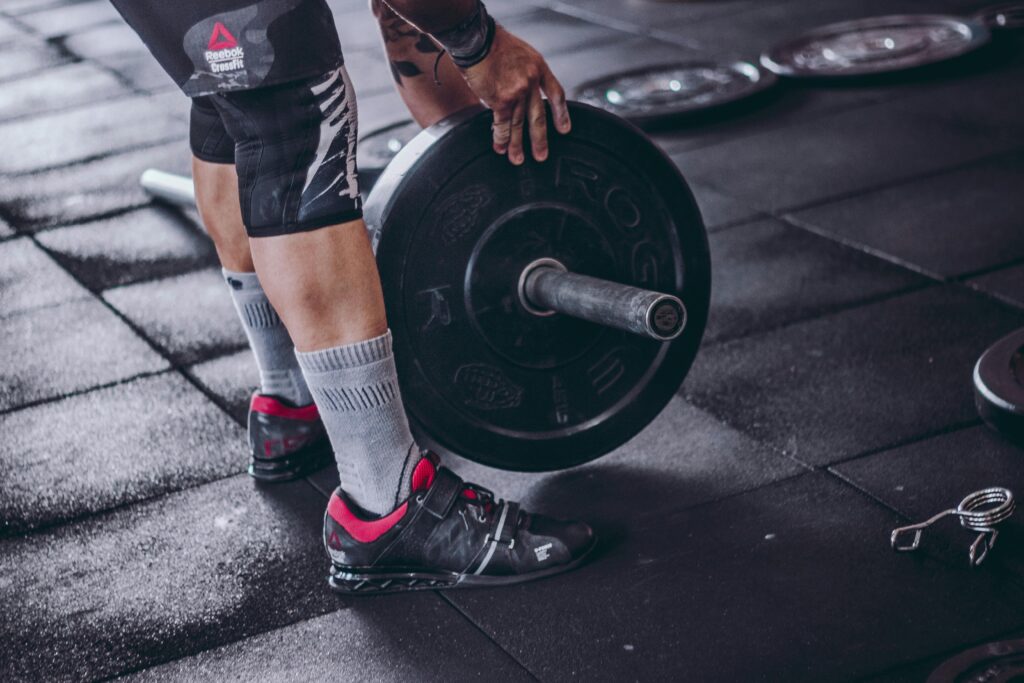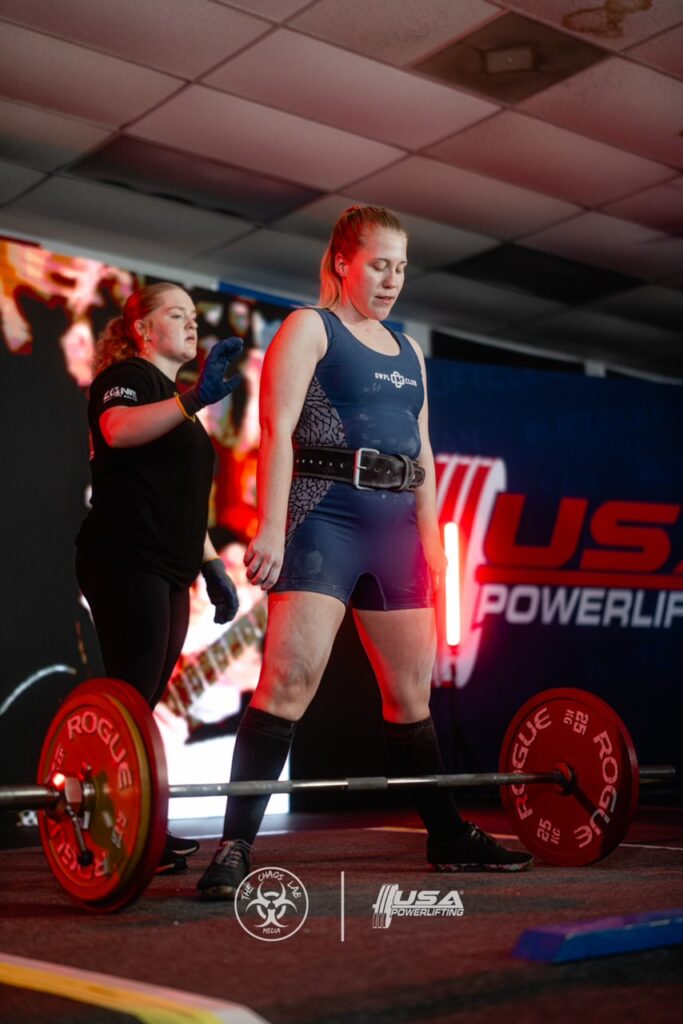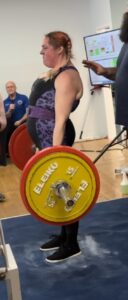How To Test Your One Rep Max
This comprehensive guide will dive into the nitty gritty of how to test your one rep max in the squat, bench and deadlift.
A 1 rep max (1RM) is the maximum weight that a person can lift in one repetition for a specific exercise.
Knowing what your one rep max is is essential if you’re a seasoned powerlifter, or just getting into, or considering getting into the world of powerlifting.
In this article, we will dive in to:
- Why You Should Test Your 1RM
- How To Work Up To Testing 1RM
- How Often You Should Test Your 1RM
So if you’re ready to find out exactly how strong you are, read on, and don’t skip around.
Why Test Your One Rep Max?
Testing and finding out what your true one rep max is can be extraordinarily beneficial.
Your 1RM provides a baseline for your current strength level.
This allows you to design your training program based on percentages of your 1RM.
Typically, as you go through different phases of your training, you will lift closer and close to your one rep max, at varying rep ranges.
For example, in a hypertrophy phase, you will lift for sets of 6-10 reps, between 60-75% of your 1RM.
While in a strength phase, you will lift for sets of 3-6 reps, between 75-90% of your 1RM.
It can be a great way to tell you how much weight to lift to challenge yourself appropriately, and provide enough training stimulus to make gains.
If you lift too much relative to your 1RM, it leads to fatigue and makes it hard to complete your lifts successfully.
If you lift too low relative to your 1RM, you won’t signal your body to be able to progress to heavier weights.
How To Test Your One Rep Max?
Testing a one rep max can be a daunting task if you’ve never done it before.
There are two key factors you need to understand.
- What your estimated 1RM is
- How to work up to your 1RM to test it.
Once you understand these principles, the guesswork is taken out of it for you, and you just have to execute.
Estimating Your 1RM
If you’ve never tested your one rep max before, you’re probably wondering how you can figure out where to even start.
But there is a very simple calculation, called the Brzycki formula to estimate your one rep max, based on previous weight lifted for a specific number of reps.
Total Weight Lifted in pounds / (1.0278 – (Number of Repetitions x 0.0278)) ≈ 1 Rep Max
You can use this handy tool by strengthlevel.com to estimate your one rep max based on the formula above.
While this formula isn’t 100% accurate, it does give is a good jumping off point for finding a maximum weight for you to shoot for.
Working Up To Your 1RM
Now I know you’re not reading this article, thinking you’re just going to load up the bar to the weight you plan to go for, and just grip it and rip it.

Any good workout involves a period of warming up.
And while you should do a dynamic warmup for mobility, muscle activation, and increasing core temperature, you should also be warming up by lifting weight.
So you should warmup for your one rep max by doing the movement you plan to test your 1RM at lighter, then progressively heavier weights, and progressively lower reps
A general framework for this might look like warming up at 40-50%, 50-60%, 60-70%, 70-80%, 80-86%, 86%-92%, 92-96%.
| Set | Percentage | Reps | Rest |
|---|---|---|---|
| 1 | 40-50% | 7-10 | 1-2 mins |
| 2 | 50-60% | 5-7 | 1-2 mins |
| 3 | 60-70% | 3-5 | 2-3 mins |
| 4 | 70-80% | 2-3 | 2-3 mins |
| 5 | 80-86% | 1-2 | 3-5 mins |
| 6 | 86%-92% | 1 | 3-5 mins |
| 7 | 92-96% | 1 | 3-5 mins |
| 8 | 100%+ | 1 | – |
While this is a great formula, it is only a guide. Some people may feel better with more warmup sets, and some less.
You can adjust this framework based on your own preferences.
Testing: The Fun Part

Now that you’ve warmed up to test, it’s now time for both the hardest, yet simplest part.
The moment of truth.
A few key factors to consider before you lay it all out on the line.
- If you haven’t tested your 1RM before, aim for the estimated 1RM based on the Brzycki formula listed above.
- If you’ve tested your 1RM before, don’t waste energy by lifting that weight again as part of your test. Try to beat that today.
- Conversely, don’t try to blow your previous 1 Rep Max out of the water. Aim for 5-10lb or 2.5-5kgs over your previous best. Otherwise you are setting yourself up for failure.
- If you succeed at your attempted weight, and are feeling good, you can try to add another 5-10lbs or 2.5-5kgs.
- If you succeed at your attempted weight, and it was an existential grind to lock it out, do not go for a new PR after that. Take the win, and walk away.
- If you’re able to, get someone to spot you. If you’re not able to, set your safeties, and do a test fail rep with just the bar.
How Often To Test Your One Rep Max
Performing a one rep max is a test of your current strength level.
Think of testing your one rep max like taking a final exam for a chemistry class.
You don’t learn more about chemistry by taking the final exam, it just shows where your current knowledge of chemistry is at that point.
You learn more about chemistry by learning the material, practicing the principles, and studying.
And just like chemistry, you don’t get stronger by performing a one rep max test.
You get stronger by consistently training with challenging weights, by building strength and muscle in different rep ranges, and refining your technique.
Novice lifters, gym bros, and ego lifters train by attempting their one rep max over and over again.
Which is like taking that chemistry exam over and over again without ever once studying for it.
Less Is More
Fatigue
Testing a 1RM is incredibly fatiguing.
This is why after my online coaching clients compete in a powerlifting meet, I give them the entire week off of training afterwards to recover.
Not just physically, but mentally.
Injury Risk
Testing your one rep max also puts you at the greatest risk for injury.
While injuries are not quite as common as people think in strength sports, they happen a lot easier when you don’t train intelligently.
And constantly testing maxes while battling the fatigue that ensues from doing so puts you at greater risk of technique breaking down.
Which ultimately puts you at higher risk for minor to major injuries.
Not Enough Stimulus To Make Gains
Strength is built through the overall volume of your training.
Training volume = Sets × Reps × Weight
So let’s say you’re doing a 1 rep max squat at 300lbs, and it’s a new PR for you.
Your training volume in the squat that day was 1 set × 1 rep × 300lbs = 300lb total training volume.
Now if you were to do 4 sets of 3 squats at 85% of your 1RM of 300lbs…
Your training volume in the squat would be 4 sets × 3 reps × 255lbs = 3,060lbs.
Now you’re accumulating volume to make gains!
How Often Should I Test?
There’s no hard and fast rule as to how often is too often, and how infrequent is too infrequent.
In my opinion, the minimum amount of time you should wait to test your 1 rep max is 12 weeks.
This gives you enough time to periodize your training.
You can go through a phase of lifting lower weights for higher reps with the goal of increasing muscle size and building work capacity for heavier weights down the line.
You can then go through a phase of higher weights for lower reps, with the goal of increasing strength in your main lifts.
And finally, if you’re choosing to test 1RMs, you can go through a phase of lifting near maximal weights for sets or 2 and 1, with the goal of lifting heavy weight and increasing neural adaptations to execute maximal lifts efficiently.
You can then repeat the cycle anew. But ideally, you’d skip a few peaking phases, incorporate different movements, and take deloads.
Thus making your 1RM testing spaced out further than 12 weeks, and not testing for 6-12 months while you really dedicate time to building strength for maximal strength gains.
There is a lot of nuance to the above phasing, and if that overwhelms the hell out of you, it’s understandable.
Navigating the intricacies of proper periodization and avoiding overtraining can be a challenge. That’s where I can help.
My online coaching program takes the guesswork out of your training. I’ll design a personalized program that incorporates strategic phases like hypertrophy, strength, and peaking blocks, just like the 12-week example provided.
 Here’s what you’ll get:
Here’s what you’ll get:
- Customized Training Plans: Programs tailored to your goals, experience level, and equipment availability.
- Periodization Expertise: Structured training phases to optimize muscle growth, build strength, and peak for 1RM testing.
- Form Analysis and Technique Cues: Ensure you’re lifting safely and maximizing your results.
- 24/7 Support: Get expert guidance and motivation whenever you need it.
Let me help you reach your strength training goals efficiently and safely. Ready to take your lifting to the next level?
Click here to learn more about my online coaching program!
Conclusion
Testing your 1RM can be a valuable tool, but it’s a means to an end, not the end itself.
Consistent training with challenging weights and proper form builds true strength.
However, testing your 1RM every few weeks can be counterproductive due to fatigue and injury risk.
Aim for an absolute minimum of 12 weeks between tests, but ideally 6-12 months will elicit the most change.
This guide provided a framework for testing your 1RM, including:
- Warm-up sets: Gradually increase weight and decrease reps to prepare your muscles and nervous system.
- Estimated 1RM: Use the Brzycki formula to get a starting point.
- Attempting your 1RM: Focus on good form and aim to beat your previous attempt by a small margin (5-10lbs).
But remember, testing too frequently has downsides:
- Fatigue: 1RM testing is demanding, requiring ample recovery time.
- Injury risk: Constantly pushing limits can lead to injuries if proper technique suffers.
- Limited training stimulus: 1RM attempts don’t provide enough overall training volume for optimal strength gains.
This can feel overwhelming, especially navigating the intricacies of periodization.
That’s where my online coaching program comes in. I’ll take the guesswork out of your training and design a personalized program tailored to your goals and experience level.
Ready to take your lifting to the next level? Click here to learn more about my online coaching program!
In the meantime, happy lifting.
Nick

